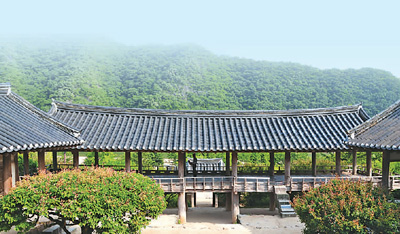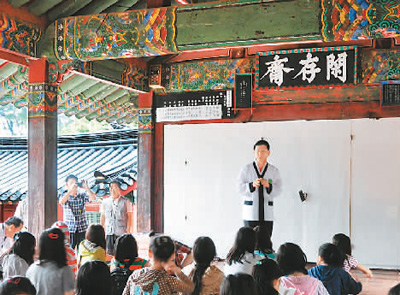Korean Confucian Academy witnessing the exchange of civilizations


Over the years, around the Dragon Boat Festival, Chinese medicine and Korean medicine, printing and Confucian classic engraving, many public hot topics have emerged. Among them, there are many misinformation, and common-sense mistakes like confusing world heritage, intangible heritage and memory engineering are also common. At this time, instead of deliberately entangled in "squatting", it is better to calm down at the same time and build a multi-dimensional coordinate system of "beauty of beauty, beauty of beauty" to improve the appreciation level of tolerance and mutual learning.
3. Visit five academies in Korea.
In 2011, the Korean government selected 9 representative colleges from the existing 637 colleges to apply for the World Heritage. I remember that when I read the English version of Korea’s related application documents, I couldn’t understand "Seowon". After reading it carefully, I suddenly realized that this word is not the transliteration of Chinese "Academy" from Korean and then translated into English.
After nine years of hard work, the Confucian Academy project declared by South Korea has finally been included in the World Heritage List. What are these Confucian academies in Korea like now? What is the unique value? Over the years, I have been to South Korea three times, walking in Gyeongsang Road, which was among the eight roads of Lee’s North Korean dynasty, and visited five academies.
Among the five academies, Pingshan Academy, located near Hehui Village, a world heritage site in Anton City, still lingers on my mind when I visit them again and again. Nowadays, tourists who come to Hehui Village can take a country road to Pingshan College for a short stay if they are still interested, but they don’t know that there is a dirt road in Hehui Village, which winds into the mountains through the rice fields at the head of the village. Walking among them, if you go up the mountain yin road and overlook the Luodong River, it flows slowly, and you stop and go, as if you were sailing with the water, and the mountains and rivers set each other off, which makes people overwhelmed. About an hour later, I arrived in front of this academy, which was built in 1613. Pingshan Academy is named after the picturesque mountains on the other side, which is generally similar to other academies’ regulations, but the special environment makes this place particularly spacious and spacious. At dusk, I boarded the building opposite to the evening, and when I looked around, the river rippled with golden waves, and the light and shadow on the other side of the cliff were displaced. The scenery was quite artistic in Du Fu’s poem, "The emerald screen should be right at night, and the white valley will swim deeply."
Hidden in the mountains, Yun Shenchu
Among these five academies, Shaoxiu Academy in Yeongju is the oldest, which was founded by the great scholar Li Kun (1501— 1570) was founded in 1543, initially named "Baiyundong Academy", located outside the entrance of Xiaobaishan National Park in South Korea. Perhaps because of the reconstruction of the old Buddhist temple site, the pattern of Shaoxiu Academy is quite different from other academies, and there is no clear correspondence between the lecture space and the sacrifice space, and the setting of the lent houses and lecture halls is also slightly scattered. However, it was recognized by Korean scholars as the first academy on the Korean peninsula because it had two functions of giving lectures and offering sacrifices at the earliest.
After leaving Shaoxiu Academy, I followed the footsteps of "Haidong Zhuzi" Li Yun, from Rongzhou to Anton, and went to Taoshan Academy, which was founded in 1561. In terms of scale, it is the largest of several Korean academies I have visited; According to the situation, this academy is backed by the lush Taoshan Mountain, and faces the mighty Luodong River in front. Cangshan Mountain has clear water, and the river is full of color and charm. After several years, I still remember that when I visited that day, it was raining cats and dogs, and I couldn’t help feeling that Taoshan Academy was really the first holy land of Confucianism in the Li Dynasty.
As for Yushan Academy and Daodong Academy, they are quite like two deep valleys and orchids. One is located in the outer suburb of Gyeongju, a thousand-year-old ancient capital, and one is hidden in the most remote Dacheng County of Daegu City. Jade Mountain Academy in Gyeongju, contrary to the traditional practice of sitting south facing north, has adopted the pattern of sitting east facing west, with small building volume and very compact layout. Daodong Academy in Dacheng County faces Luodong River, accompanied by towering ginkgo biloba in front of the door, and the pavilion at the entrance is named Shuiyue Building, which makes people wonder that if they visit on the night of "full moon on March 5", they can see the scenery of "and the moon comes running up the river".
Might as well "beauty of beauty"
The two most famous academies in China — — Bailudong Academy and Songyang Academy were included in the World Heritage List in 1996 and 2010 respectively as part of the "Heaven and Earth" historical buildings in Lushan and Dengfeng. As for the Confucian Academy in South Korea, the system imitates China’s early academy, and even its original Baiyundong Academy imitates the Lushan Bailudong Academy reconstructed by Zhu Xi in name. It should be noted that the English name of Korean heritage project is "Seowon, Korean Neo-Confucian Academies". If Neo-Confucian is translated into "neo-Confucianism" or "neo-Confucianism" without thinking, then the complexity of the meaning of "neo-Confucianism" in Chinese context is ignored, so it is better to follow the Chinese tradition and call it "Korean Confucian Academy".
Lee’s Korean dynasty worshiped Confucianism, but as the scholar Ge Zhaoguang said, we can’t simply confuse the traditions of several East Asian countries. Specific to the Confucian Academy in Korea, the architectural layout refers to the configuration form of "Korean Mountain Temple" which was listed as a world heritage last year. Under the same social background and land use conditions, these academies have formed a completely different architectural model from mountain temples. Therefore, it has a direct role in promoting the formation of the so-called "true landscape" landscape concept of the Korean dynasty after the 18th century.
Stones from other mountains can attack jade. The sense of solemnity that Korean academies continue to maintain is a relatively intact part of their cultural heritage of East Asian academies. This is also where we should study now. It is said that there are as many as 15,000 teenagers who go to Shaoxiu Academy to study traditional etiquette for three days every year. I still remember coming to Taoshan Academy, which is far away from the small town of Anton, on a non-weekend time six years ago. At that time, it was raining heavily, but a group of primary school students who were wearing raincoats but wet from head to toe came to visit. Under the guidance of the staff dressed in Confucian clothes, the children chirped into the Canon Church, and after a while they began to listen and read. In the quiet, they looked solemn and dignified, and the moment when the wind and rain sounded like reading was quite antique (see Figure 2).
(Qiao Lujing text/map)